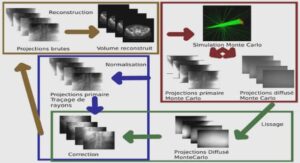Clichés du cinéma hollandais
Les films de la société Hollandia terminent de sortir à la surface grâce à l’inv entaire et en particulier une très grande trouvaille: OP HOOP V AN ZEGEN (1918). Cette fiction montre la difficulté de rendre accessible un film en fragments même s’il es t identifié comm e un classique de la culture néerla ndaise. Ce qui reste est aussi symptomatique de la situation physique des archives du cinéma muet néerlandais. Delpeut offre un bilan des archives du ci néma muet néerlandais publié en 1997: « Paging through the filmography of Dutch silent fiction films compiled by Geoffrey Donaldson, one is immediately struck by the fact that film footage for three quarters of the assembled titles is no longer available. Even when footage has been preserved, it often amounts to little more than a fragment. (…) We have to rely on photos, publicity material and reports on contemporary newspapers and magazines to get a sense of what characterised and typified these production companies. And yet we are not entirely empty handed. What ever managed to survive the ravages of time –as tattered and torn as it was – has been carefully smoothed, restored and preserved by the Netherlands Filmmuseum. And from that material we can reconstruct a history –however fragmented and sketchy –of what was projected on the screen and seen and experienced by audiences.”
l’importance que ces film s ont encore pour le public contemporain. Delpeut évoque la façon dont il travaille m algré ces vides et ces oublis: « What is about these films that will strike a modern audience ? To begin with, a screen that spills over with the myriad clichéd images that every Dutch traveller abroad still has to endure: windmills, tulips, clogs, national costumes, fishing ports, trawlers and seiners. Holland seems to be little more than narrow strip of dunes along the coastline. Of course, I’m exaggerating. These fiction films do give a broader view of Holland, but the lingering impression of an excess of folklore is indelible. As was the case in literature, advertising and the emergent tourist industry (…) an image that has stubbornly persisted for the best part of the century. First and foremost because this ‘Holland’ had a commercial value that was eagerly exploited. Dutch silent films eagerly joined in, trying to engage with an international film culture more than has been possible since the advent of the talkies. Windmills, tulips and clogs were (still are) a trademark. (…) There are of course, other truths about Holland to be found in these films. In fiction films the implicit or explicit desires, passions and frustrations of a land and its people can be discerned. That Holland, inasmuch as I could recognise and understand it (past is and remains a foreign country), surprised and astonished me. The world presented does not express much optimism; it is a gloomy place where evil, usually in the form of a compelling emotion or a a forbidden passion, is ruthlessly punished. Even the farces are harsh and merciless. The characters in Dutch silent films are roughly pulled into line; behaviour that deviates from bourgeois morality is not tolerated. Seen from this perspective, these images provide material for a Dutch history of ideas during the first three decades of this century (…). 355 Et ces film s muets sont bien plus dive rs et passionnants que nous-m êmes nous ne soupçonnions pas au principe de ce travail de recherche. Cett e Hollande entre le folklore et la mentalité d’une époque est rep résentée dans OP HOOP VAN ZEGEN (1918). Dont les fragm ents fonctionnent comme un échantillon qui perm et d’approfondir les caractéris tiques du cinéma muet néerlandais tel qu’il est valorisé au NFM en 1989.
Un classique de la culture néerlandaise : OP HOOP VAN ZEGEN (1918)
OP HOOP VAN ZEGEN (1918) se trouve en fragm ents. S’il n’y a que des morceaux, qu els sont-t-ils ? C’est un film impossible à restaurer, donc difficile à présenter. Il faut aborder l’importance de ce film dans le contexte de la culture néerlandaise pour comprendre pourquoi Delpeut cherche à le programmer convenablement. En 1989, il y a un intérêt vif po ur les préservations de la société Hollandia et leur programmation. L’équipe édite un programm e de compilation conçu exprès sur la société HOOP VAN ZEGEN (1918) m ême si ses traces sont lim itées. C’est un film considéré comme emblématique de la culture néerlandaise. Parce que c’est la première adaptation à l’écran de la pièce de théâtre écrite, en 1900, par Herm ann Heijermans (1864-1924). C’est l’écrivain, Le titre OP HOOP VAN ZEGEN est traduit littéralement, à peu près comme « dans l’espoir d’être béni », et il signifie « en espérant que tout ira pour le mieux » ou encore « à Dieu va ». La pièce publiée en français comme La Bonne Espérance, c’est un drame social et réaliste sur l’exploitation des travailleurs de la m er. Pièce cons idérée comme un classique du théâtre et peut-être la plus blanc. Ces prises sont m arquées avec un num éro et dénom ination « Engeland ».364 Selon Donaldson et Delpeut, se basa nt sur les synthèses publiées du film, ces prises n’étaient pas utilisées dans la version néerlandaise de 1918. Il s’agit très probablement d’un projet d’édition pour le marché anglais dont la fin a été changée. Elle montre les marins qui rentrent chez eux de façon inattendue, pour se r éunir avec leur famille qui les croya ient morts. Delpeut remarque: « However, we seem to have stumbled on something specific, something that was considered to strike the right note with Dutch audiences. This is suggested by the fact that several films with an ‘unhappy ending’ before being sold to the foreign market (……) not only takes the sting of Heijermans’ special criticism but, more importantly, it ignores the inevitable course of the ‘drama of the sea’: A story about those who remain behind, the women at home who, deprived of their husbands, sons or lovers, must live on a ‘pan of soup and charity’. And it goes against the enjoyment of the ‘unhappy ending’ that the Dutch silent cinema nurtured and repeated in film after film.” »





